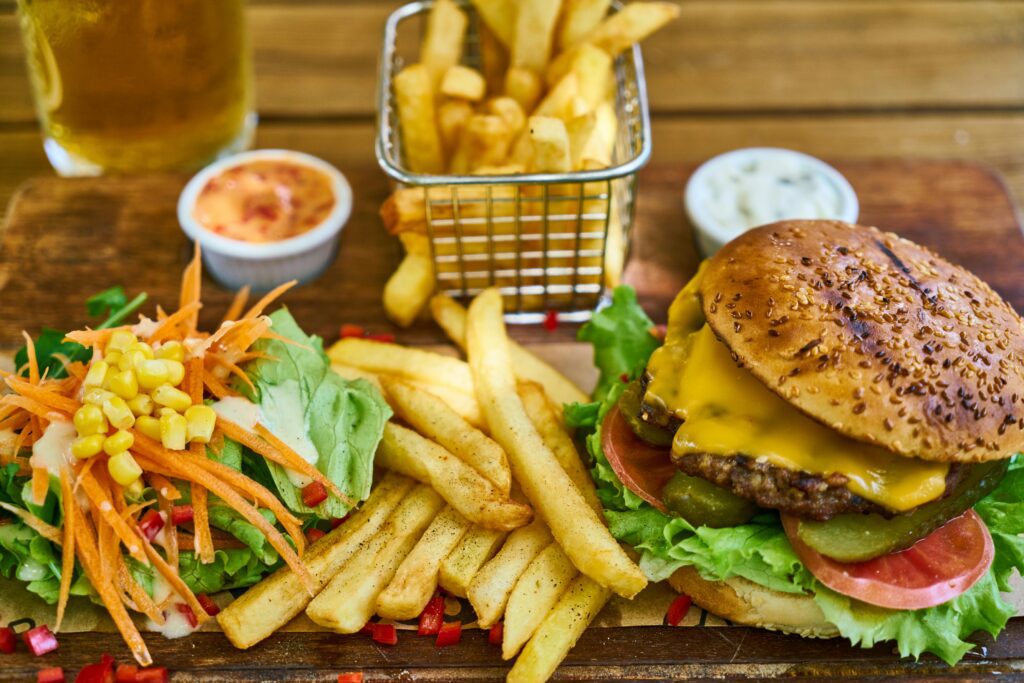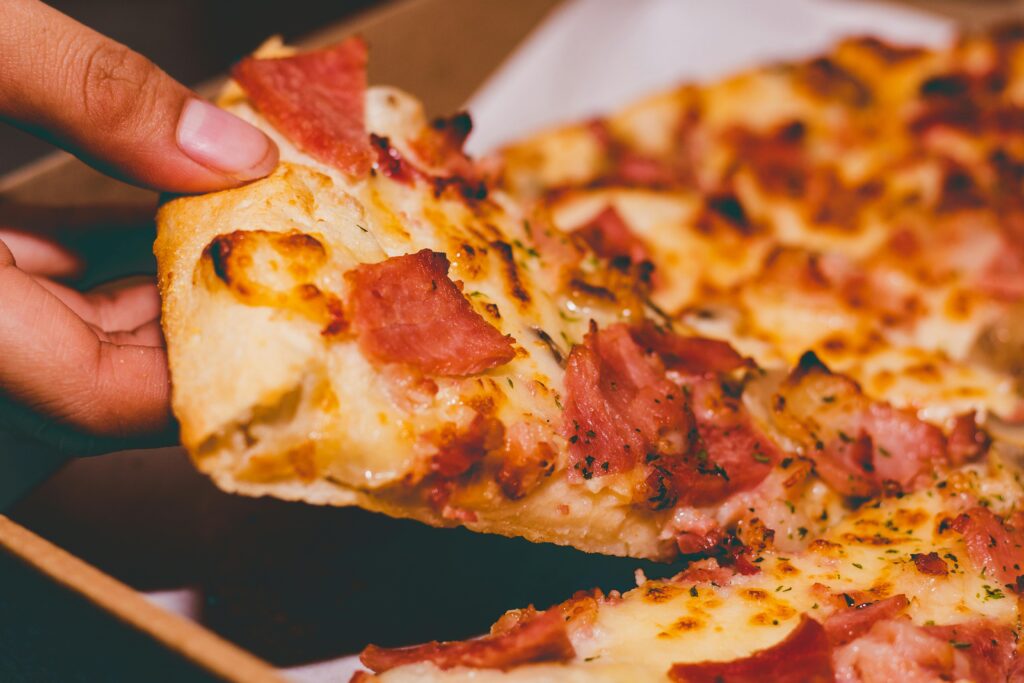Exploring Healthy Fast Food Options: A Comprehensive Guide

1. Introduction to Fast Food and Health
The combination of fast food and good health may seem like a paradox at first glance. But elsewhere, it is a reality. Fast food menus now comprise large varieties of healthy choices. A healthy diet means having a variety of foods, nutrients, balanced calories, and good fats.
In many cases, fast food contains hidden calories, sugars, fats, or preservatives that affect health conditions. Still, healthy options can be sought out. Thankfully, the fastest-developing industry in the world contains alternatives that can continue to stimulate take-out meal sales while meeting consumers’ need for more wholesome selections 1.
Competition among fast-food chains has driven brands to keep up with the growing demand for healthier options. Fast food may have a bad rap for calorie piling of unsatisfying options loaded with sugar and fat. But more and more choices are popping up on menus to alleviate worries over unexpected calorie surges and improve health with mindful consumption.
Having a better perception of the impact that fast food can have on health and well-being invites the exploration of healthier options. It is important to know that fast food can have many different effects on health depending on the choice of selection, intake amount, and frequency of consumption 2.
1.1. History and Evolution of Fast Food Industry
Fast food has become a huge industry in North America. This form of commercial food service provides a quick alternative to eating at home for many people and has become part of the lifestyle in larger cities. Many fast food outlets focus on providing a variety of hamburgers and soft drinks, whereas others provide fried chicken and pizza.
It is claimed that fast food has the advantage of convenience by eliminating the time and effort spent shopping and preparing food. However, there are also advantages of eating at home and a number of discussions have emerged on the debates surrounding fast food.
The concept of fast food can be traced back to 1867 in New York City, when pre-cooked and canned foods were created. In 1912, a chain of restaurants began where the same food, decor and service style were offered. Modern outlets came along in 1921 and 1954, which standardised food and service to limit variability, and commodity-like franchises took hold 3.
When first introduced, the fast food industry catered primarily to white, upper-middle-class families. However, those who granted the franchises soon discovered that African Americans represented a lucrative market. In the late 1940s, African Americans rode buses five to eight miles to restaurants that would serve them, and a few franchises, such as White Castle, began to cater to black neighbourhoods.
Since then, African Americans have become the primary consumers of fast food, and now businesses are highly concentrated in inner-city black neighbourhoods. In fact, 39% of all high-fat fast food restaurants in the U.S. are in these areas. The industry grew extensively in the 1960s, and within the next decade, many major national chains such as McDonald’s and KFC began to expand overseas 2.
1.2. Health Concerns Associated with Exploring Healthy Fast Food Options: A Comprehensive Guide Traditional Fast Food

The combination of sugar, fat, and sodium in typical fast food meals makes them taste good and can contribute to the development of chronic diseases. Soda or sweetened drinks, French fries, cheeseburgers, onion rings, malts, etc., are often high in sugar, palatable fats, sodium, and/or calories.
Fast food consumption is associated with significantly lower intakes of key nutrients, such as fibre, calcium, and several vitamins. Regular fast food consumption adversely affects metabolic abnormalities. Several studies have reported associations between fast food consumption and the risk of insulin resistance, type 2 diabetes, metabolic syndrome (MetS), cardiovascular disease (CVD), and CVD risk factors such as sedentary behaviour, obesity, hypertension, and hyperlipidaemia.
Recent findings by Bahadoran, Mirmiran, and Azizi (2016) showed worse waist circumference, blood pressure, triglyceride level, and fasting glucose concentrations in the group consuming fast foods at least twice a week. Also, an increase in the risk of being overweight was noted with less fruit and vegetable consumption.
Health concerns associated with fast food consumption have been drawn not only from epidemiologic studies but also from clinical research. Consumption of fast foods ≥2 times/week increased the risk of insulin resistance 1. Metabolic syndrome (MetS) could be a consequence of fast food consumption.
Large-scale cross-sectional epidemiologic studies that provide a solid understanding of the association of fast food consumption with metabolic disorders are limited. Non-alcoholic fatty liver disease (NAFLD) may be a possible sequel of fast food consumption. This review warns not only against the consumption of fast foods but also about public health concerns, especially the increasing burden of obesity and cardiovascular diseases.
The need for further large-scale cross-sectional and longitudinal studies is emphasised to shed more light on the effects of fast food consumption on the increased burden of diseases. There is an urgent need for alternative fast food options that are healthier in terms of fat, sugar, and sodium content. It is vital that healthier alternatives to conventional junk/fast food eateries be sought in light of these concerns 2.
2. Nutritional Guidelines for Healthy Eating

Eating healthy means making choices that provide the nourishment your body needs. Choosing foods wisely ensures a well balanced intake of nutrients. Building a diet based on food choices from the different food groups reduces your chances of an inadequate or excess intake of nutrients.
The energy that foods provide is measured in calories. Eating too many calories may result in being overweight. Eating too few calories may diminish your strength and endurance levels. Keeping close to the number of calories you need for your age, sex, and level of activity is a good way to know if you are getting enough energy from your food choices.
Healthy eating involves understanding serving sizes. The different food groups each have recommended serving sizes. Use the basic food pyramid to determine the number of servings needed. Adhering to the recommended servings decreases the chances of eating too much or too little from that food group. The basic food pyramid does allow for some discretion. It’s important to keep in mind that moderation is the key when making food choices that are high in sugar and fat 4.
2.1. Caloric Intake and Portion Control
Caloric intake is the most probable factor contributing to body weight gain or weight loss. Body weight is maintained off of a balance between caloric energy consumed and energy expended by non-food activities, like exercise and bodily functions 5. Whenever caloric intake exceeds energy expenditure, it can lead to increased body weight and fat; when expenditures surpass calories consumed, weight is lost in return.
Caloric density, the number of calories per gram of food, is a crucial aspect of food choice. Foods with high caloric density, such as potato chips and fast food, typically lead to weight gain. Nonetheless, caloric density does not elucidate all concepts of food choice since many people still consume food that results in weight gain, despite knowing the caloric cost.
In a similar respect, portion control policy targets the amount of food that consumers have access to. Portion control in food choices can be an influencing factor in weight change beyond caloric density. A range of different portion control strategies regarding restaurant food have been introduced, connately with policies. For instance, one section of background examines whether counting food prior to consumption affects portion control in calorie-dense foods, looking at the implicit process in monitoring consumption after each food item 6.
Another background section explores different approaches to food choice alterations for social comparison, like power and social image that are mechanisms for observed social pressures altering decisions. There are appropriate ways to repurpose while preventing certain phrasing.
2.2. Balancing Macronutrients: Carbohydrates, Proteins, and Fats

Balancing macronutrients, which includes a combination of carbohydrate, protein, and fat intake, is vital for health and wellbeing. 7 recommend that three macro-nutrients—carbohydrates, proteins, and fats—should be consumed in at least a minimum proportion on a daily basis to support physical activity, such as work necessary for life.
It is generally considered that fifty-five to sixty-five percent of daily calories, that is, kilocalories (kcal), should be from carbohydrates, fifteen to twenty-five percent from proteins, and twenty to thirty-five percent from fats 8. Thus, which ever fast food chain outlets you are going to visit, this information will greatly assist in making informed choices from their menu.
Carbohydrates are a group of sugars comprised of carbon, hydrogen and oxygen at a ratio of 1:2:1 respectively. They include sugars commonly used in the diet for energy, such as glucose, sucrose, galactose, starch, and arabinose, among many others. Carbohydrates are the most abundant macronutrient in the diet.
There are two main classes of carbohydrates: Simple or quick-digesting carbohydrates provide instant energy sources; and complex or slow-digesting carbohydrates provide longer-lasting energy sources. Simple carbohydrates are found in food such as white sugar, honey, jam, candy, and syrup, while complex carbohydrates can be found in items such as pasta, bread, and potatoes.
3. Popular Healthy Fast Food Chains
Fast food is often associated with unhealthy meal choices, but there are plenty of popular fast food establishments that offer options that are well under your daily caloric needs. These include:
Chipotle: It’s one of the most popular fast food chains in recent times and also has nutritious choices. Beef, chicken, and guacamole act as sources of protein. Pico de gallo, lettuce, and corn salsa add additional vitamins. A salad with vinaigrette dressing is about 300 calories. It’s a popular choice due to the customisable ingredients and sauces.
Burger King, also known as BK has a few decent choices, like the grilled chicken sandwich. Lettuce, tomato, and onion add essential vitamins without increasing calories by much. Skip the mayo and sauces to keep the meal under the caloric threshold. Subway: It emphasises “healthy” ingredients and encourages customising your own meal choices, which can be a huge win for anyone.
A 6 inch sandwich with turkey breast, lettuce, and tomatoes contains about 280 calories. Choose wheat bread to add fiber. – Chick-Fil-A – The well-known grilled chicken sandwich has only 320 calories. Additional vitamins can be found in the lettuce and tomato. You can also order a side salad or fruit cup instead of the fries. – Panera Bread – A popular chain that serves coffee and baked goods but also has soups, salads and sandwiches. The Mediterranean Veggie Sandwich is the go-to option with only 540 calories.
It’s packed with proteins from the humus and fresh ingredients like spinach, peppers, and tomatoes. – Starbucks – Mostly famous for its coffee drinks but has breakfast menus with nutrition in mind. The Spinach, Feta & Egg White Wrap is about 290 calories and a good source of protein. It’s also delicious and filling. Taco Bell: At first glance, it’s hard to choose a viable option from Taco Bell.
However, the Fresco Chicken Soft Taco is around 150 calories. It’s a corn tortilla filled with grilled chicken, tomatoes, and lettuce. A side of black beans or fiesta salsa can be ordered as well. – White Castle – At the bottom of this list due to its slim pickings, stands the famous burger joint. White Castle does have a grilled chicken sandwich that is only 210 calories. Marinara sauce and mozzarella are an optional add-on, but keep in mind that they increase the calories 9.
3.1. Menu Options and Nutritional Information
Fresh is the most popular choice on the Chipotle Mexican Grill menu. The meat in the tacos and burritos is naturally raised, antibiotic-free, and vegetarian-fed. The chips and beans are also cooked in-house, and the soda is free of high fructose corn syrup.
The menu options at Chipotle Mexican Grill are burritos, bowls, tacos, salads, sides, drinks, and kids’ meals. The nutritional information varies for each food option. For example, burrito nutrition ranges between 460 calories and 1250 calories, depending on the food’s content. Similarly, salad nutrition ranges between 320 calories and 845 calories.
Subway
Two menu options have been chosen at Subway. First, the “Our Favourites” sandwich, a standard sub that has a memorable name and taste. The customers cannot pick the sandwich’s parts, such as the style of bread, sauce, meat, and toppings 9. At Subway, the menu options are a total of 38 fresh sandwiches, wraps, and salads. The nutritional information is 340 calories with 900 mg of sodium. The second is a “Build Your Banger” sandwich, a custom sub. Customers are allowed to mix and match all the elements in any vegetable or variety. At Subway, the menu options are breakfast subs and on-the-go s-chokes. The nutritional information is 642 calories with a majority of 973 sodium.
4. Tips for Making Healthier Choices

Here are some tips on how to make healthier choices at a fast-food restaurant:
Fast food can be quick and convenient, but if you’ve decided to eat there, you don’t have to abandon your healthy eating goals. With some knowledge and planning, you can make fast food choices that are better for your health. Your best option is to eat healthy foods as a regular part of your diet, so you won’t feel pressured to eat anything unhealthy when faced with fast-food choices.
Familiarise yourself with the quick, healthy options available at your favourite fast food places before you go, and then make a conscious decision to stick to your plan when ordering.
Choose grilled rather than fried items. Fried chicken sandwiches, fried fish sandwiches, and fried fish fillets usually have double the fat and calories of their grilled or baked counterparts. Use caution with items that have been “crispy” added, such as “crispy chicken sandwiches.” Oven-baked or non-fried variations may be healthier options than fried ones.
French fries are obviously the most fattening side item, but onion rings can be nearly as bad. Instead, choose a low-fat side, such as a side salad or fruit.
Choose sandwiches with just one meat. You put two servings of meat in your stomach when you order a double-decker sandwich. This typically means double the amount of fat and calories. In particular, avoid items like the Big Mac and the ¼-pound cheeseburger. These can add a third pound of meat, fat, and sodium to your diet! Instead, opt for a simple sandwich with just one or two patties of meat. Better yet, order a salad or side.
Make healthy substitutions. Ask for toppings like lettuce, tomato, pickles, onions, or mustard to be added if they aren’t already there. Many fast-food restaurants are beginning to provide healthier options like spiced grilled chicken, sprouts, or avocado. On the other hand, avoid adding mayonnaise, cheese, and special sauces, all of which can add a large amount of fat and calories to your sandwich. Ask for mayonnaise or salad dressing to be served on the side, or use them sparingly.
Choose larger-sized items with care. Order the small or medium burger, rather than the large if there’s a choice, and choose the small fries rather than the large. Be wary of “super sizes,” which are often more food than people need for a meal.
Large sizes can add several hundred calories to an item. Avoid bread items with more than one slice. In addition, cinnamon rolls and dessert extremes, which can top 600 calories, are to be avoided as well. To keep the meal healthy, share meals or desserts when dining with others.
4.1. Smart Ordering Strategies
When dining at fast food restaurants, consumers can implement the following strategies to navigate menu items and meal deals to make healthier selections. First, understand that not all menu items offer equal opportunities for improvement. For example, salads and grilled chicken sandwiches often present opportunities for reducing calorie intake, while fries and sodas present few options.
Target items first that present good opportunities and then build upon strengths by focusing on the healthier aspects of existing menu items. If purchasing a concept like hamburgers, focus on items with healthier versions like grilled chicken. To refine meal deals, select smaller portion sizes of fries and sodas before upsizing portions. Second, seek products and meal deals with healthy branding.
Certain products provide consumers with cues about their nutritional quality and improve their ability to make healthy choices 10. Consumer-perceived healthy brands are mostly positioned within the salad category at McDonald’s (e.g., southwest grilled chicken salad). When combining multiple healthy products within one meal, branding of conjunction-based healthy meal deals improves the selection of healthy combinations further, e.g., grilled chicken sandwich salads.
As healthy meal deals register greater media coverage and cites from health experts, this strategy is more impactful with consumers who chronically seek healthy dietary behaviour. Third, recognize that higher prices do not always communicate healthier options. Some price promotion strategies trigger the unhealthiest choices 11.
For instance, at Subway’s $5 foot-long promotion, awareness of 12-inch sub sandwiches at that price may draw consumer interest away from 6-inch sandwiches, which are generally the best choice. Separating healthy items and meal deals from unhealthy options using price formats and signs further improves healthier choices. While some meal deals (e.g., value menu) de-emphasize the categories of bundled unhealthy options and products (e.g., non-fried sandwiches), consumers believe these deals are all unhealthy.
4.2. Substitutions and Modifications
When considering healthier items at fast food restaurants, modifications or substitutions can make an incredible difference. Most fast food items are not just a burger; they usually come as a meal, meaning a drink and a side. These components can make the meal healthier, even if the items in question are not modified.
However, when taking into account the broad approach of improving meal choices instead of food items, the alterations will increase tremendously. Some of the most useful alterations for eating healthy at fast food chains will be presented here.
If the food item is a burger, consider substituting chicory, bean, or veggie patties. These choices are much lower in fat and calories than a beef patty. Cheeseburgers will have to be asked to be ordered without cheese. Skip fried items; side salads or apple slices are alternatives that are low in fat and calories.
Order single burgers—those double bacon cheeseburgers come with a lot of calories and saturated fat. The best bet for drinks is water, skim milk, or unsweetened tea, as they contain no calories or high fructose corn syrup. “Diet” drinks that use artificial sweeteners are often loaded with sodium and should be avoided.
Even fruit juices are often very high in sugar and should be refrained from 4. Not purchasing any dessert is also an excellent option along the same lines; don’t forget that desserts can be very high in fat and calories. Fruit and yogurt parfaits may be the best option.
At some fast food chains (often those that don’t limit alternatives), items can be ordered without components that contain a lot of calories or are currently considered unhealthy. Simple burgers can be ordered without mayonnaise. If the bun is not whole-grain, it can be asked to be substituted with a wrap, lettuce, or removed altogether.
On salads, anything fried should be omitted as it adds calories and fat dramatically. Undressing salads is also a very good option, as anything that comes with ranch, Caesar or creamy dressings contains a lot of fat. If the salad is a taco salad, skip the shell and rely on the lettuce, as it is very low in calories and fat 5.
Also read: Empower Weight Loss Unlocking Your Path to a Healthier You
5. Conclusion and Future Trends
Healthy food has been in the spotlight since fast food was introduced and widely popularized among people due to their convenience. In recent years, the growing awareness of obesity and other health issues related to diet has led to the introduction of healthy options in fast food chains, and some have gone fully green.
In the midst of busy lifestyles, fast food may still prove to be a solution to avoid mounting stress or wasted time waiting for food or searching for a place to eat. As the possibility of eating healthy in fast food chains has become known, this section has compiled creative ideas of healthy meals, or searching for hidden healthy fast food options.
As meal types are grouped, breakfast meals would include Egg and Sausage Muffin, Egg White and Cheese Muffin, and Egg White Delight. Lucky customers may also find oatmeal or yogurt. For lunch or dinner meal types, healthy fast food chains have sandwiches or wraps with chicken salads, or salads tossed with a light dressing.
Some fast food outlets also serve grilled rather than fried chicken, and baked potatoes would provide good resistant starch that keeps hunger away a lot longer than fried options. For dessert, yogurt and fruit parfaits are good choices, along with fruit cups without syrup. A rather simple fix would be to skip ordering fries and soda.
These options contain saturated fats, preservatives, and sugar, and a meal feels incomplete without them – hence risky choices of upsizing a meal. Instead, ordering baked potatoes with salad dressing on the side, or bottled water with fruit cups, would offset some guilt. This, good choices, and recommendations combined to help minimize the damaging health impacts of fast food would be helpful 3.
Use of simpler, common words makes these good choices unique and easy to understand. The ideas encourage taking initiative or planning ahead whilst boosting creativity. It focused on what, despite limited degrees of freedom, may be the healthiest meals. Whatever the achievement may lead to, it is reminded that the significant goal is to recognize that the chains serve healthy food as well, whether or not one believes them or enjoys fast food. Efforts should be made to constantly search for or create better diets and choices.
In anticipating future trends, attempts to introduce omissions or substitutions rather than introducing new dishes may suffice. Chain restaurants should have contingency plans; for example, List Kings may serve false choices with heavy sauces at the owner’s wishes. Food chains need to be more cautious or creative in repackaging rather than playing it safe with the limit of new items 9.
References:
1. Bahadoran Z, Mirmiran P, Azizi F. Fast Food Pattern and Cardiometabolic Disorders: A Review of Current Studies. 2016. ncbi.nlm.nih.gov
2. Matyolo P. Consumers’ attitudes towards ready-to-eat fast-food products and their relationship with obesity in Mdantsane township in the Eastern Cape Province, South Africa. 2017. [PDF]
3. Ooi J, Yazdanifard R. How do Fast Food Chain Restaurant can still sustain their Business despite Controversial Health Related Issue. 2014. [PDF]
4. S. Boeckner L. NF01-499 Tips for Eating Out. 2001. [PDF]
5. Alert A, Hollis J, Lanningham_Foster L, Wolff M. The Influence of a Nutrition Recommendation on Food Choices in a Virtual Fast-Food Restaurant. 2022. ncbi.nlm.nih.gov
6. Lyons J, Walton J, Flynn A. Larger food portion sizes are associated with both positive and negative markers of dietary quality in Irish adults. 2018. [PDF]
7. A. Wali J, M. Solon-Biet S, Freire T, E. Brandon A. Macronutrient Determinants of Obesity, Insulin Resistance and Metabolic Health. 2021. ncbi.nlm.nih.gov
8. J. Venn B. Macronutrients and Human Health for the 21st Century. 2020. ncbi.nlm.nih.gov
9. S Creel J, R Sharkey J, McIntosh A, Anding J et al. Availability of healthier options in traditional and nontraditional rural fast-food outlets. 2008. ncbi.nlm.nih.gov
10. Riis J. Opportunities and Barriers for Smaller Portions in Food Service: Lessons from Marketing and Behavioral Economics. 2014. [PDF]
11. Kraak V, Englund T, Misyak S, Serrano E. Progress Evaluation for the Restaurant Industry Assessed by a Voluntary Marketing-Mix and Choice-Architecture Framework That Offers Strategies to Nudge American Customers toward Healthy Food Environments, 2006–2017. 2017. ncbi.nlm.nih.gov